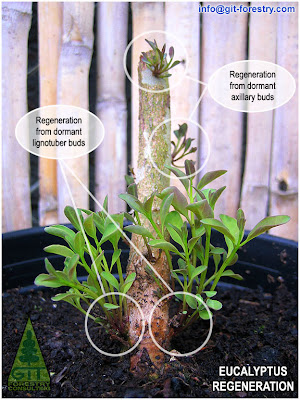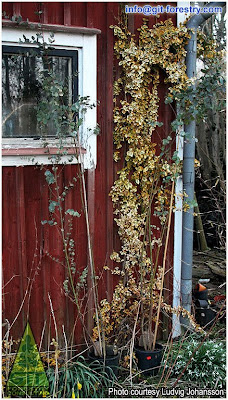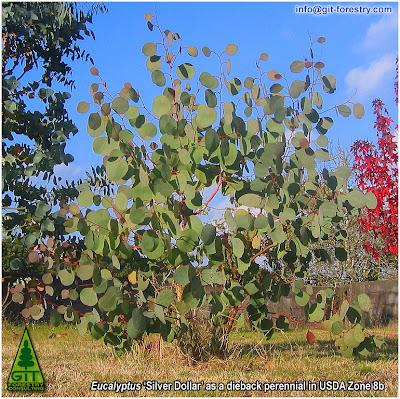Eucalyptus regeneration: tips & tricks for potted plants
Gustavo Iglesias Trabado
GIT Forestry Consulting - Consultoría y Servicios de Ingeniería Agroforestal - www.git-forestry.com - EUCALYPTOLOGICS
Gustavo Iglesias Trabado

GIT Forestry Consulting - Consultoría y Servicios de Ingeniería Agroforestal - www.git-forestry.com - EUCALYPTOLOGICS
We have previously seen in EUCALYPTOLOGICS a good number of examples of Eucalyptus regeneration at their natural habitats in Australia, timber plantations overseas and garden designs using these plants. Today we re-visit this topic from an angle that can be useful for those growers having overgrown potted eucalypts. A new outlook for those plants can be achieved taking advantage of Eucalyptus stubborness to survive.
 Fig. 1: Initial stage of Eucalyptus regeneration by coppicing a potted specimen at nursery. New shoots emerge both from lignotuber and dormant axillary buds. (Click image to enlarge)
Fig. 1: Initial stage of Eucalyptus regeneration by coppicing a potted specimen at nursery. New shoots emerge both from lignotuber and dormant axillary buds. (Click image to enlarge) Fig. 2: Advanced stage of Eucalyptus regeneration by coppicing a potted specimen at nursery. (Click image to enlarge)
Fig. 2: Advanced stage of Eucalyptus regeneration by coppicing a potted specimen at nursery. (Click image to enlarge) Fig. 3: Overgrown potted Eucalyptus suitable for recycling via coppicing. (Click image to enlarge)
Fig. 3: Overgrown potted Eucalyptus suitable for recycling via coppicing. (Click image to enlarge)Advantages of Recycling Potted Eucalyptus
- A new outlook can be developed for specimens with poor form, signs of damage in their aerial part or having an aesthetic attractive below average
- Can help assess comparative coppice vigour for different species, varieties or provenances, many of which are rare in cultivation
- Growth rates can be faster than from seed to seedling since root systems are already formed
- Allows further decisions once re-shooting is ongoing as formation pruning, bonsaification or shape sculpture
- Forces the plant to produce new shoots of juvenile foliage, which can be interesting if this is the main ornamental feature
- Keeps a door open to future annual or biannual severe pruning, starting over as the plants gain more size than desired in order to keep them as smaller potted specimens for display or as indoor plants
Disadvantages of Recycling Potted Eucalyptus
- More suitable for specimens having already developed a lignotuber, albeit this is not always necessary
- More suitable for fast growing Eucalyptus species, and better if juvenile leaf shapes are an important ornamental feature
- Too old potted plants may be rootbound and might require root pruning and transplanting to bigger pots for this technique to yield best results
- In most cases root quality is inferior in the long term compared to potted plants grown directly from seed to seedling and needing no coppicing, especially if these are grown using root air pruning techniques
- Coppice timing must match appropriate seasonal conditions: plants need light, warm temperature and abundance of water and nutrients to rebuild... but pruning risks must be minimised
- Coppice results are variable from specimen to specimen within the same plant lot, shape homogeneity is difficult to achieve sistematically without intensive observation and frequent interventions
- Nutrient availability can be low or exhausted in an old potting mix, making a proper fertilisation/fertirrigation regime necessary
Also in EUCALYPTOLOGICS
 Eucalyptus as dieback perennials: taking advantage of plant resurrection
Eucalyptus as dieback perennials: taking advantage of plant resurrection Eucalyptus Vegetative Regeneration = Lignotuber + Trunk buds
Eucalyptus Vegetative Regeneration = Lignotuber + Trunk buds Growing Eucalyptus from seed: it is in the details
Growing Eucalyptus from seed: it is in the details Subscribe to receive EUCALYPTOLOGICS via RSS
© 2008 Gustavo Iglesias Trabado. Please contact us if you want to use all or part of this text and photography elsewhere. We like to share, but we do not like rudeness.





No comments:
Post a Comment